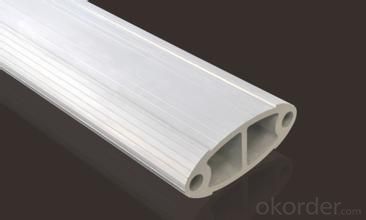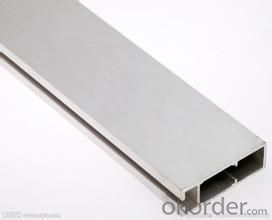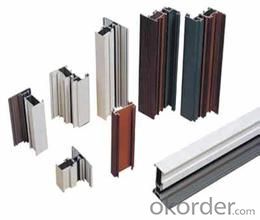Aluminium Extrusions for making Ship Mast
- Loading Port:
- Shanghai
- Payment Terms:
- TT OR LC
- Min Order Qty:
- 5 m.t.
- Supply Capability:
- 1000 m.t./month
OKorder Service Pledge
OKorder Financial Service
You Might Also Like
Item specifice
1. Structure of Aluminium Extrusions for making Ship Mast Description
Aluminium Extrusions for making Ship Mast is one semi-finished aluminium material. The alloy AA6082 T6 is widly used in building, industry ect. Its weight is much lower than steel. So many customers choosed aluminium material instead of steel.
2. Specification of Aluminium Extrusions for making Ship Mast
Aluminum Extrusion | |
Main Specification | |
Alloy | AA1xxx (AA1050, AA1060, AA1070, AA1100 etc.) |
AA3xxx (AA3003, AA3004, AA3005, AA3105 etc.) | |
AA5xxx, AA6XXX (AA5052,AA5083, AA5754, AA6061, AA6062 etc.) | |
AA8xxx(AA8011, AA8006 etc.) | |
Temper | H14,H16, H18, H22, H24, H26, H32,O/F, T4, T6, T651 |
Thickmess | 0.01mm-100mm |
Width | 30mm-1700mm |
Standard | GB/T 3880-2006/ASTM |
Special specification is available on customer's requirement | |
3. Application of Aluminium Extrusions for making Ship Mast
(1).Interior: wall cladding, ceilings, bathrooms, kitchens and balconies, shutters, doors...
(2).Exterior: wall cladding, facades, roofing, canopies, tunnels,column covers , renovations...
(3).Advertisement: display platforms, signboards, fascia, shop fronts...
4. Feature of Aluminium Extrusions for making Ship Mast
Surfact Quality :
Be free from Oil Stain, Dent, Inclusion, Scratches, Stain, Oxide Dicoloration, Breaks, Corrosion, Roll Marks, Dirt Streaks and other defect which will interfere with use,
Mechenical Property:
Chemical Composite and Mechanical Property
5. Certificate of Aluminium Extrusions for making Ship Mast
SGS and ROHS(if client request, paid by client), MTC(plant provided), Certificate of Origin(FORM A, FORM E, CO), Bureau Veritas and SGS (if client request, paid by client), CIQS certificate
6. Image of Aluminium Extrusions for making Ship Mast



7. Package and shipping of Aluminium Extrusions for making Ship Mast
First, plastic cloth with drying agent inside; Second, Pearl Wool ; Third, wooden cases with dry agent , fumigation wooden pallets, aluminum surface could cover blue PVC film
8. FAQ
1) What is the delivery time?
Depends on actual order, around 20 to 35 days
2) What is the QC system:
We have QC staff of 20 persons and advanced equipment, each production is with MTC traced from Aluminum ingot lot.
3) What market do you mainly sell to?
Australia, America, Asia, Middle East, Western Europe, Africa etc
- Q:How do you select the appropriate aluminum profile for a specific application?
- To select the appropriate aluminum profile for a specific application, one must consider several factors. Firstly, the desired strength and durability of the profile should match the requirements of the application. The profile's dimensions, such as length, width, and thickness, should also be chosen to fit the intended purpose. Additionally, considering the environment in which the profile will be used is essential, as factors like corrosion resistance, temperature resistance, and weight-bearing capacity will impact the selection. Moreover, the specific design features and compatibility with other components or structures should be taken into account. Lastly, considering the cost and availability of the chosen aluminum profile is crucial to ensure it aligns with the project's budget and timeline.
- Q:Can aluminum profiles be an alternative to steel or iron?
- Aluminum profiles offer a viable alternative to steel or iron in numerous applications due to their lightweight, durability, and exceptional resistance to corrosion. These qualities make them suitable for diverse industries like construction, automotive, aerospace, and electrical. Unlike steel or iron, aluminum exhibits a high strength-to-weight ratio, enabling it to provide equivalent strength while being significantly lighter. Consequently, aluminum profiles are easier to handle, transport, and install, resulting in reduced overall costs. Moreover, aluminum profiles can be easily extruded into intricate shapes, allowing for design flexibility and customization. Nevertheless, it is crucial to acknowledge that aluminum profiles might not be suitable for all applications requiring the high strength or hardness offered by steel or iron. Hence, the decision between aluminum, steel, or iron profiles will rely on the specific requirements of the project or product.
- Q:How do you clean and maintain aluminum profiles?
- To clean and maintain aluminum profiles, you can start by removing any loose debris or dirt using a soft brush or cloth. Then, prepare a mixture of mild soap or detergent with warm water. Gently scrub the profiles using this solution, ensuring to reach all the nooks and corners. Rinse thoroughly with clean water, and dry the profiles with a soft cloth. To maintain their shine, you can apply a small amount of aluminum polish or a non-abrasive metal cleaner, following the manufacturer's instructions. Regularly inspect the profiles for any signs of damage or corrosion, and promptly address any issues to prevent further deterioration.
- Q:What are the different color options for aluminum profiles?
- Aluminum profiles come in a variety of color options, catering to different aesthetic preferences and functional needs. Here are some commonly chosen colors: 1. Natural aluminum: This option emphasizes the raw and metallic look of aluminum, giving it a sleek, modern, and minimalist appeal. 2. Anodized finishes: By undergoing an electrochemical process called anodizing, aluminum develops a protective layer that enhances its durability and resistance to corrosion. Anodizing also offers a wide range of color choices, including black, bronze, gold, silver, as well as vibrant shades of blue, red, green, and other colors. 3. Powder coating: Another popular method for coloring aluminum profiles involves applying a dry powder to the surface, which is then cured under heat to create a durable and visually appealing finish. Powder coating provides a vast selection of colors, including standard options, metallic finishes, and special effects like textures and patterns. 4. Painted finishes: Liquid coatings can be used to paint aluminum profiles, allowing for a broader spectrum of colors that can be customized to match specific design requirements. Painted finishes offer versatility and can be applied with different gloss levels, such as matte, satin, or high gloss. 5. Wood grain finishes: For those seeking a wood-like appearance without the maintenance that comes with actual wood, aluminum profiles can be finished with a wood grain pattern. This option combines the durability of aluminum with the warm and natural look of wood, providing a wide range of wood species and finishes. Ultimately, the choice of color for aluminum profiles depends on personal preference, architectural style, desired durability, and the overall design concept.
- Q:Can aluminum profiles be used in agricultural applications?
- Yes, aluminum profiles can be used in agricultural applications. Aluminum is a versatile and durable material that can withstand various environmental conditions. It can be used for constructing greenhouse frames, irrigation systems, equipment supports, and other agricultural structures. Aluminum profiles offer excellent resistance to corrosion, are lightweight, and have high strength-to-weight ratio, making them suitable for use in agricultural applications.
- Q:What are the advantages of industrial aluminum profiles? What are the problems that should be paid attention to?
- Aluminum profile is the aluminum bar through different degrees of hot melt, extrusion, so that it forms different shapes of aluminum materials, aluminum profiles are widely used, often used in construction, home improvement, industry and so on.
- Q:Can aluminum profiles be used for electrical applications?
- Aluminum profiles possess the capability to be utilized in electrical applications. Given its high conductivity, aluminum emerges as an ideal choice for facilitating electrical conduction. In the realm of electrical applications, aluminum profiles frequently find employment in power distribution systems, wiring conduits, and bus bars. By virtue of being lightweight and cost-effective, they present a favorable solution for electrical installations. Moreover, aluminum profiles exhibit commendable thermal conductivity, successfully aiding in the dissipation of heat emitted by electrical components. Nevertheless, it remains crucial to duly factor in the specific requirements of the electrical application at hand, ensuring that the aluminum profiles adhere to the requisite electrical safety standards and regulations.
- Q:How are aluminum profiles cut and shaped?
- Aluminum profiles are cut and shaped using various methods such as sawing, milling, drilling, and bending. Sawing is the most common method, where a circular saw or bandsaw is used to cut the aluminum profiles to the desired length. Milling involves removing excess material using a rotating cutting tool to create specific shapes and designs. Drilling is used to create holes in the profiles using a drill bit. Lastly, bending is employed to shape the profiles by applying force to bend them into the desired angles or curves.
- Q:Are aluminum profiles suitable for use in automotive body structures?
- Yes, aluminum profiles are suitable for use in automotive body structures. Aluminum is lightweight, strong, and corrosion-resistant, making it an ideal material for constructing car bodies. Its high specific strength allows for increased fuel efficiency and better performance. Additionally, aluminum profiles can be easily shaped and formed to meet the specific design requirements of modern vehicles.
- Q:What is the maximum length of aluminum profiles available?
- The length of aluminum profiles that are available can differ based on the manufacturer and the specific product being considered. In broad terms, aluminum profiles can be made in lengths that range from a few inches to numerous feet. While certain manufacturers may provide standard lengths like 6 or 12 feet, others may possess the capacity to create custom lengths according to the customer's needs. To ascertain the maximum length possibilities for a particular aluminum profile, it is essential to consult with the manufacturer or supplier.
1. Manufacturer Overview |
|
|---|---|
| Location | |
| Year Established | |
| Annual Output Value | |
| Main Markets | |
| Company Certifications | |
2. Manufacturer Certificates |
|
|---|---|
| a) Certification Name | |
| Range | |
| Reference | |
| Validity Period | |
3. Manufacturer Capability |
|
|---|---|
| a)Trade Capacity | |
| Nearest Port | |
| Export Percentage | |
| No.of Employees in Trade Department | |
| Language Spoken: | |
| b)Factory Information | |
| Factory Size: | |
| No. of Production Lines | |
| Contract Manufacturing | |
| Product Price Range | |
Send your message to us
Aluminium Extrusions for making Ship Mast
- Loading Port:
- Shanghai
- Payment Terms:
- TT OR LC
- Min Order Qty:
- 5 m.t.
- Supply Capability:
- 1000 m.t./month
OKorder Service Pledge
OKorder Financial Service
Similar products
New products
Hot products
Hot Searches
Related keywords































